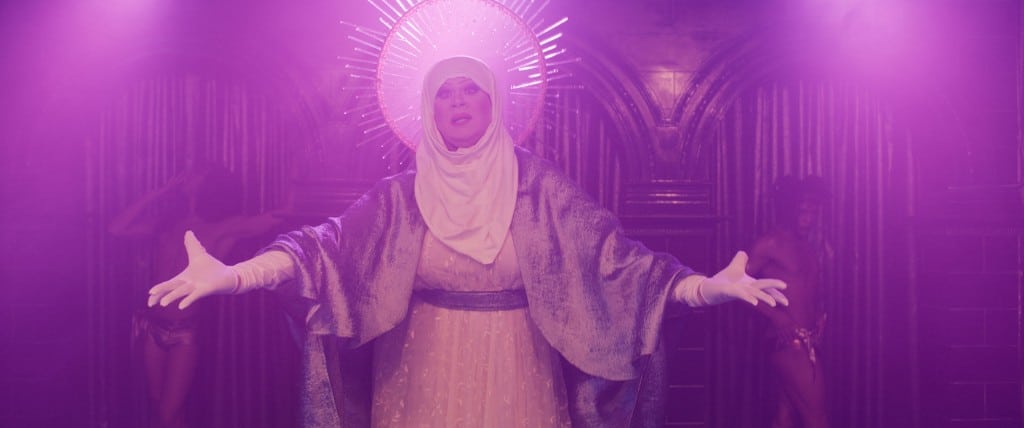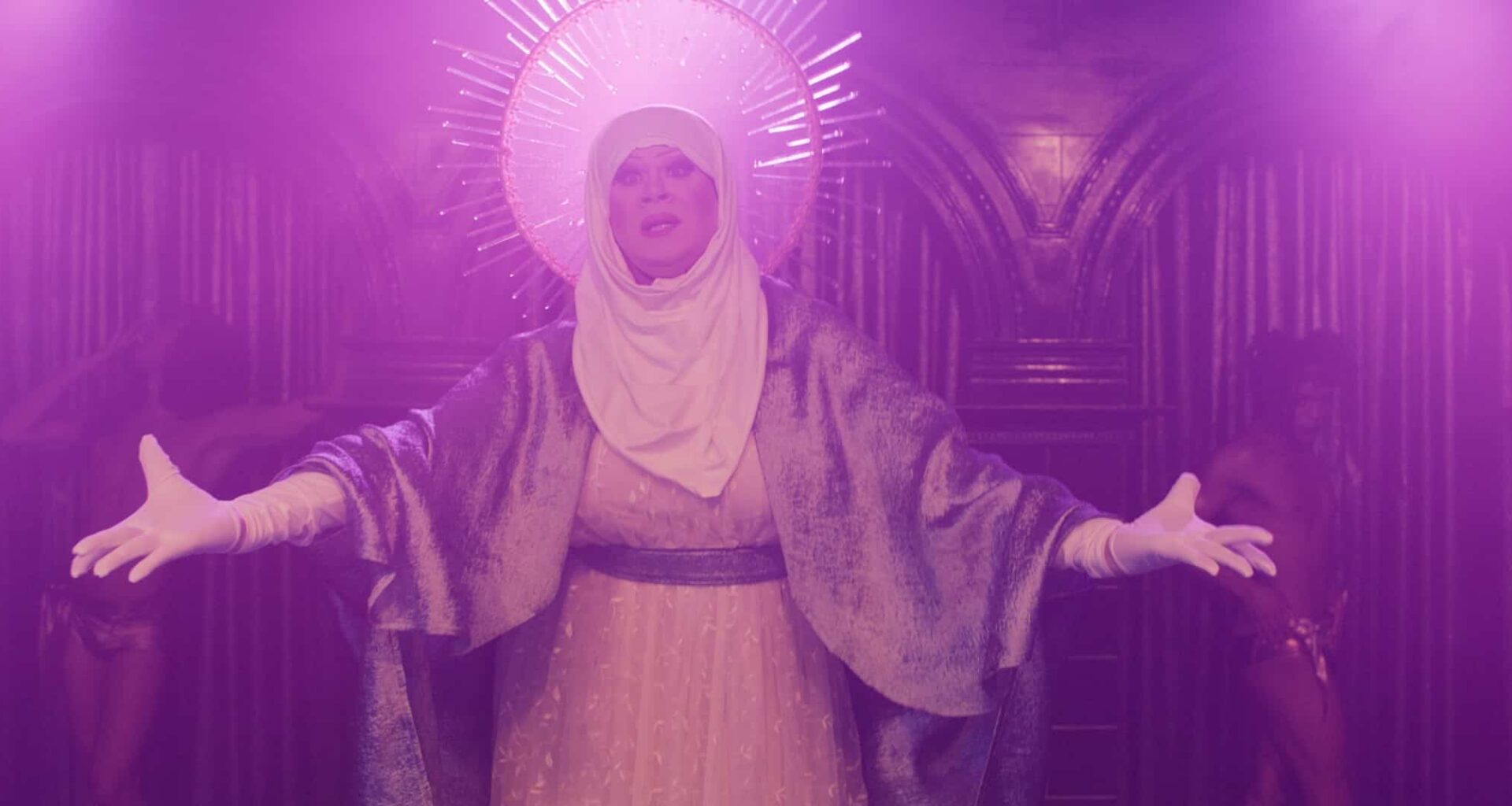 Nina West in Tina Romero’s QUEENS OF THE DEAD. Courtesy of Shannon Madden. An Independent Film Company and Shudder Release.
Nina West in Tina Romero’s QUEENS OF THE DEAD. Courtesy of Shannon Madden. An Independent Film Company and Shudder Release.
In 1968, George Romero made the genre-defining classic Night of the Living Dead, in which random people fleeing an outbreak of flesh-eating zombies hole up in a house and try to get past their differences to see the dawn. In 2025, the late filmmaker’s daughter, Tina Romero, has resurrected her father’s spirit with her directorial debut, “Queens of the Dead,” while also injecting the new “zom-com” with a fresh sense of silliness and a timely focus on the LGBTQIA+ community.
In her biggest screen role to date, Nina West, the Columbus-based drag star, activist, philanthropist, and co-author of the new book No Tea No Shade: Life as a Drag Queen, co-stars as veteran drag artist Ginsey Tonic. What starts as just another cabaret night run by struggling promoter Dre (Katy O’Brian) becomes a battle for the survival of a multi-generational group of performers, club staff, and family members, with Ginsey playing a key role as headliner, mama bear, and makeover queen. The cast also includes Margaret Cho, Jaquel Spivey of the musical adaptation of “Mean Girls,” regular Ryan Murphy collaborator Cheyenne Jackson, and “I Saw the TV Glow” co-star Jack Haven.
West, as her offstage self Andrew Levitt, will introduce the Ohio premiere of “Queens of the Dead” at Nightmares Film Festival on Sunday, Oct. 19, followed by a post-film Q&A. She’s long been associated with spooky season locally as founder of the Axis Halloween show “Heels of Horror,” and it was one of West’s creepier onstage characters that led to her casting.
“My friend Zelda Williams had done a film project called ‘Lisa Frankenstein,’” West said. “We had befriended each other because I had created a character also called Lisa Frankenstein. She sent me this lovely little note that said, ‘You’re not going to believe this. My friend Tina Romero is working on this movie and your picture’s on her vision board for this character.’ Then through Zelda, Tina sent me an email a couple months later saying how much she saw me in this role and wanted me to be a part of it.”
West said of her character Ginsey, “I think she really represents nightlife… someone who has been embattled in the cause, has been in this fight for a long time, is also very motherly and maternal in her care and her guidance for not only the venue but the people who are in the venue. She has a relationship that far outsteps that venue into the community. And I think that only speaks to the greater role of drag.”
In line with the way that drag artists have acted as ambassadors for the queer community, the horror genre has long served as a means for putting queer coding in front of mainstream audiences. Examples range from queer actor Ernest Thesiger’s work with his friend, openly gay Hollywood filmmaker James Whale (most notably in 1935’s “The Bride of Frankenstein”) to the glaring subtext in cult favorites such as 1985’s “A Nightmare on Elm Street 2: Freddy’s Revenge” and “Jennifer’s Body,” from 2009.
“Queens of the Dead” centers and empowers this community that has historically been only alluded to or worse, victimized in horror, and Tina Romero has continued her father’s legacy of using zombie incursions as allegories for real-life societal issues, such as racism in the original “Night of the Living Dead” and class chasms in 2005’s “Land of the Dead.”
Kicking things off by drawing a clear line from drag finery to Catholic mass vestments, “Queens” also touches on the superficiality of influencer culture and the cruelly random definition of “essential workers” during a crisis – laid out in a fun cameo by longtime George Romero collaborator Tom Savini. Above all, the film immerses viewers in the proud, resilient culture it represents. As West noted, it’s a community that has experience from the height of the AIDS crisis in dancing its way through hell.
“It’s addressing these social issues so wonderfully,” West said of the film. “It’s going to give audiences the opportunity to see themselves onscreen, to understand our nuances and our [shorthand], and how the language does mean something to people who have experienced this community. It will also give them the opportunity, I think, to feel a sense of joy, giving them permission to have laughter in a dark time period that has otherwise taken a lot of that away.”
West said her experience shooting “Queens” last summer was bookended by the disastrous performance from Joe Biden in the June 2024 presidential debate and the more formidable turn by Kamala Harris in her September debate with then-candidate Donald Trump. And the uncertain political future infected on-set conversations about the film being made.
“Our language for talking about these things was vast because we didn’t have the understanding of what was going to be happening right now,” she said. “It exists in a specific moment in time, but it couldn’t be more valuable or more pressing that this film is being released during this specific period where we are fighting fascism, regardless of how anybody else wants to reframe this. We’re fighting against the decline of democracy. We are fighting people who are taking away access to healthcare for all, but specifically LGBTQIA+ folks, and then even more specifically our trans community.“
“How we talk about these things should hopefully be accessible to the audience that’s seeing it,” West added, “so that they themselves feel empowered to speak up and fight against the zombies that exist in this real world, the big bad that exists in this real world, which is the current president and his administration and what they’re seeking to do, which is take away rights not from just anybody, but from all of us.”

